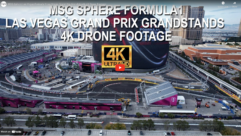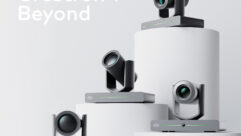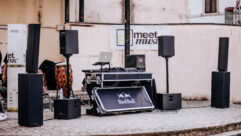
In this edition of the SVC Podcast, SVC Contributing Editor Bennett Liles talks with Alan Eidson of Eidson Studios in Little Rock, Ark., about his sound and video installation at the newly opened Lincoln Heritage Museum on the campus of Lincoln College in Illinois. Working with museum experts Taylor Studios of Rantoul, Ill., Eidson wired and tested the interactive exhibits that tell the story of our 16th president from childhood to his untimely death at the hands of an assassin in Ford’s Theater. He also details his use of Alcorn-McBride processing and show control to bring the exhibits to life.
Links of interest:
- The Alcorn-McBride V16 Pro Show Controller used to coordinate the interactive exhibits
- Technovision TC1NET Touch Controllers for proximity sensing
- Museum Technologies BB-200 microwave motion detectors
- Dayton Audio MA1240a multi-channel amplifiers
Download Podcast Here:
https://s3.amazonaws.com/nb-svc/public/public/5_1_14-Lincoln-Heritage-Mu…
May 1, 2014 10:15 AM,
With Bennett Liles

Listen to the Podcasts
|
Editor’s note: For your convenience, this transcription of the podcast includes timestamps. If you are listening to the podcast and reading its accompanying transcription, you can use the timestamps to jump to any part of the audio podcast by simply dragging the slider on the podcast to the time indicated in the transcription.

How do you tell the story of Abraham Lincoln’s life with audio, video, and all sorts of electronic sensors that didn’t exist in his time and make it look convincing? Alan Eidson of Eidson Studios was called in to install all of this for the Lincoln Heritage Museum at Lincoln College and he’s about to tell us the story right here on the SVC Podcast.
Alan Eidson from Eidson Studios out there in the Little Rock area, it’s great to talk to somebody right in the middle of the country.
Hi, Bennett. Thank you for having me.
And what’s been happening at Eidson Studios? I know we’re going to be talking about the project at the Lincoln Heritage Museum, but what sort of stuff do you do generally at Eidson Studios?
Well, Eidson Studios, we’re an interactive exhibit design, content creation, and integration company. We’re a full-service video and audio production company and I’m considered what’s called an interpretive filmmaker. So most anything museum and exhibit in nature is called interpreting, so in short, we make documentary shorts in both audio and video for museums and federal and state parks and then we integrate what we create, too. [Timestamp: 1:31]
So we have a brand new museum opened on the campus of Lincoln College in, of all places, Lincoln, Ill., and these exhibits trace the life and death of Abraham Lincoln. And it was all brought from concept and design to reality by museum experts Taylor Studios in Rantoul and they brought you in to install all of the new AV gear and the triggered playback devices.
That’s correct. Yeah, they did the design, the fabrication, and then I come in and make the content and integrate the interactives and audio and video. [Timestamp: 2:01]

I’ve done a couple of the podcasts on museum exhibits where there’s a lot of interactive audio and video systems and it’s all pretty much on autopilot from the day it opens. When you install one or two of these activated playbacks it looks like fun, but when you have something like this one with dozens of them it could get sticky. Do projects like this really get more interesting than just putting in PA systems and video monitors?
Oh yes, of course, and it’s parallel to the visitor’s experience. People want to touch things. They want to have things start up. They want to interact. And so yeah, it’s much more interesting for me as the integrator and designer as it is the patrons, the visitors. So yeah, it’s much more complex; it’s much more fun. There’s layers and layers and layers of intricacy there. We try to pull it off to where it just looks like it’s natural and easy. [Timestamp: 2:56]
Lincoln College already had the museum but they changed locations to someplace bigger because of all the material they had acquired?
Yes. They had an existing older building with the museum and they had this idea that they wanted a big facility and so it morphed through several different things. But they have a nice, big facility that’s comprised of two different floors. It’s adjacent to some other classrooms and that type of thing, but it’s a brand new facility and it’s been a dream of theirs for quite awhile to have this nice museum to tell the story that they wanted to tell about Abraham Lincoln. [Timestamp: 3:36]
And it covers his life, his politics, and his death, too; a profound historical event, the first presidential assassination. Did Lincoln College get right into the idea of having all of the interactive sound and video exhibits or was that concept something that came along later after they had gotten started on the new location?
It was all from the beginning because what they wanted to do was something that’s not done a lot in museums. It’s telling a story from the first person, so with this Lincoln College exhibit, they created this story of Abraham Lincoln’s, basically it’s a life review. It starts from being shot in the presidential box at Ford’s Theater and ends with him passing away at the boarding house. So the exhibit is pretty dark and objects depicting parts of his life are oversized and skewed. It’s all within the concept that he was mortally wounded and hanging onto life for those two hours from when he got shot to when he died. It’s basically him telling the story of his childhood; going from a child to a young man, getting into politics, some of the other things that he got into before politics and eventually getting to the White House, leaving Indiana and going to Illinois and all of those political things. And then, of course, you witness him dying at the end. It’s a unique concept in the museum world. Most things aren’t told in first person, so we had actors. [Timestamp: 5:12]
May 1, 2014 10:15 AM,
With Bennett Liles

A lot of pre-production went into it because I think there was something like 53 different video and audio programs that went into this.
Right. Right. Yeah, there’s many layers to it, between 45 and 53, depending on if you count the little track loops and that type of thing. But yeah, there’s lots of video and audio throughout the thing. And there’s lots of things that you touch and things that you wouldn’t think that you could turn into a button, we turn into a button to start these things. [Timestamp: 5:40]
Yeah, it would have been a lot easier and probably less expensive to have just let people walk through and push buttons, but buttons and switches really wouldn’t have fit very well with the period that’s portrayed here. Most museums don’t want you to touch things but in this one you really need to touch things to get the whole effect.
Yes, it’s encouraged. You pretty much have to touch things to get the full experience.
And you decided to put in an Alcorn-McBride show controller to sense all of these inputs and run the whole thing?
Right. Right. Yeah, the V16 Pro is our show controller. We picked the V16 because Taylor Studios and I, we have a long history of working with these types of machines and controllers and video players. The Alcorn-McBride’s processing power was what we needed for this. It’s just not that the V16 Pro was in itself what we wanted to do by itself, it was a whole package. We wanted something to be able to communicate well with the video and audio processors too, and with all the lighting and DMX controllers and that type of thing. So we decided to go Alcorn-McBride pretty much all the way from show controller down to lighting control down to audio and video processing. [Timestamp: 6:55]
And that stuff is pretty bullet-proof, too.
It’s tough stuff, yeah. Many different layers of what it can do. It’s good stuff.
How many different sensors are there? Is everything touch triggered or are there infrared proximity sensors? How does all of that work?
Both. There’s basically 32 touch and motion sensors. Motion sensors are microwave type of motion sensing. It’s a smarter technology that knows when you’re approaching the motion sensor as opposed to walking away from it. And then we have proximity sensors, capacitive type of proximity sensors that we turn different objects into buttons. We have a quilt, a plow, an ax, books, dollhouses, a rose – most anything. [Timestamp: 7:46]
Yeah, I didn’t think about it, but I guess that would be an important factor whether it senses that you’re moving toward the exhibit or away from it. Because timing on this must be critical to get it exactly right.
Timing is very important with this exhibit. The whole experience takes about an hour and 20 minutes, and so in order to maintain the flow of patrons, the timing is very important.
And some of those proximity sensors were from Technovision?
Yeah, Technovision. It’s a company in Canada and he makes many different things. He makes video and audio processors, and this particular component is called the TC1. It’s a proximity sensor. It’s a touch-top sensor. It’s a capacitive discharge circuit is what it is. It’s real similar to static electricity that builds up when you walk across some carpets. It’s at a much lower level, but basically the capacitance is the ability of a surface to store electrical charge. And so with non-conductor materials you just incorporate a conductive type of material within or under the object that you want to turn into a touch zone, and you control the sensitivity of the touch zone with different-sized capacitors. So basically you’re creating a full circuit when you touch or get close enough to the capacitive touch sensor to create that circuit between you and the ground. You don’t feel it or anything; it’s just a very minute electrical current. [Timestamp: 9:15]
And of course some of what’s triggered is video playback. I think there’s some rear screen projection involved in this. What size images come up when they’re triggered?
Well, they’re pretty big. What it does, when you first get into the exhibit, you’re in the foyer of Ford’s Theater and you hear Our American Cousin, which was the play that Abraham Lincoln was going to go see when he was assassinated. You hear that going on on the other side of the wall basically. We have automatic doors that open up into the Ford Theater box area. And so basically what happens is when the show starts, there’s a little introduction thing that goes on, and then you are sort of transported into the presidential box at Ford’s Theater to witness him getting shot. And so the wall, through rear projection, looks like it just opens up a hole into the box at Ford’s Theater. It’s quite large. It’s life-sized. The image we project is basically 144in. by 81in., which is 12ft. by 6.5ft., something like that—almost 7ft. It’s quite a large projection area. One of the things we had to get over was we only had about 6ft. of throw space, so we used some ultra-wide video projectors to do that with. [Timestamp: 10:43]
And I take it there are lighting changes that are also triggered by the various sensors?
Oh sure, yes. There’s lots of lighting. It’s pretty dark and really colorful between the audio and video that’s going on to create the moods that we wanted to. We incorporated two DMX machines to control the whole house there, and so we have total control over all the lights, 400 or so different fixtures. We used a lot of little LED fixtures to make pen lights here and there and gobos. There’s lots of designs. It’s very theatrical, actually. [Timestamp: 11:22]
Lots of interactive AV in portraying the life of Abraham Lincoln and the museum has just opened and people are coming through and experiencing it. The Lincoln Heritage Museum on the campus Lincoln College. I know you did a great job and thanks for telling us about it.
Sure, Bennett. Thanks for having me and yes, if you’re in the little town of Lincoln, Ill., stop on by Lincoln College and see a first-person rendition of Abraham Lincoln’s life as it passes before his eyes. [Timestamp: 11:51]
Thanks for joining us for the SVC Podcast with Alan Eidson of Eidson Studios in Little Rock. In part two, Alan will tell us about the Alcorn-McBride ProTraxx 16-channel audio player and Digital Binloop he used to tell the story of Abraham Lincoln at the newly opened Lincoln Heritage Museum, on the next SVC Podcast.










